Series III Swansong – D402 GHP
Reproduced with permission of Classic Jaguar magazine (December 2019)
CARS FROM THE COLLECTION – PART TWO
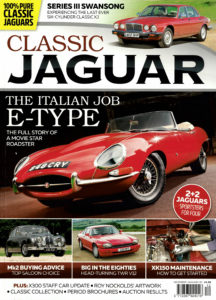
Classic Jaguar
December 2019
This second instalment in our series featuring the cars of the Jaguar Daimler Heritage Trust focuses on the very last six-cylinder Series III XJ – a stunning example with just 3000 miles under its wheels.
The March 1979 launch of a Series III version of the evergreen XJ was an important event for Jaguar. Thanks to a wide range of useful updates and more than a hint of modernisation, the XJ was suddenly all set for the ‘80s, giving Jaguar’s long-running saloon range a competitive edge against an array of increasingly popular imported rivals. Needless to say, the Series III proved to be a big hit, remaining in production even after the launch of the all-new XJ40 generation in October 1986.
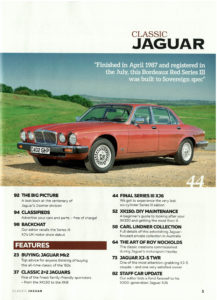
Classic Jaguar
December 2019
D402 GHP Page 5
The XJ12 Series III famously enjoyed an extended career, staying on sale right through to 1992, when it was finally usurped by a V12-engined version of the XJ40. Even the six-cylinder models overlapped the XJ40, however, with the final Series III XJ6 not being produced until April 1987.
Fast-forward to late 2019 and that’s the very same car we’re featuring here, a historically important Series III 4.2 Sovereign that’s now part of the Jaguar Daimler Heritage Trust’s hugely impressive collection.
This is a significant survivor in more ways than one, for not only is D402 GHP the final XJ6 Series III of all, it is also the very last Jaguar to be powered by the ubiquitous XK powerplant, an engine that first saw the light of day way back in 1948.
We will, of course, happily acknowledge that the XK unit lived on (albeit in very limited numbers) in the hand-built Daimler Limousine, which remained in production through to 1992. But when it comes to Jaguars, this Series III is the last to be XK-powered – a fact that surely makes it deserving of the publicity we’re giving it here.
NEW-LOOK SALOON
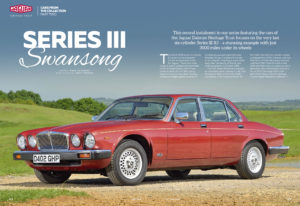
Classic Jaguar – December 2019
Series III Swansong
D402 GHP Pages 44-45
Updating a luxury saloon that had already seen a decade of production was a potentially difficult task, with Jaguar having to combine the requirements of its traditional customer base with the need for a more modern offering. The intriguing part of all this, however, is that the Series III was never part of the original plan, as development work on the XJ40 had begun at an early stage in the XJ’s career. Indeed, the all-new replacement for the XJ was intended for launch by the end of the ‘70s, yet in reality wasn’t to be seen for another six years. And so, as a short to medium-term solution, Jaguar’s only logical course of action was to update what it already had, hence the Series III XJ of early 1979.
The ‘70s hadn’t been a happy time for British Leyland’s most upmarket car division, with financial constraints, industrial relations issues and falling sales adding to Jaguar’s woes. The marque started the decade on a high, with a record 32,589 cars being produced in 1971 – an annual figure that had slumped to just 20,205 by 1975, plunging still further (to a mere 14,861 cars) by the final year of the ‘70s. Jaguar was running at only 40 per cent capacity and was losing vast sums of money, a situation that inevitably caused problems when it came to new-model launches.
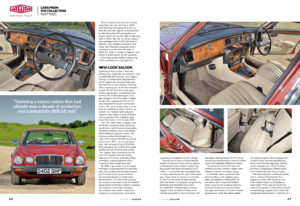
Classic Jaguar – December 2019
Series III Swansong
D402 GHP Pages 46-47
By 1979, a genuinely new XJ range had been in development for the best part of a decade, and actually existed as a full-size mock-up by the time the updated Series II models were announced in ’73. With work virtually grinding to a halt due to the formidable issues faced by British Leyland in general and Jaguar in particular, however, the decision was made to keep the existing XJ in production via a never previously anticipated Series III range.
The end result was a comprehensive facelift of Jaguar’s long-running saloon, a remarkable achievement considering the project had been allocated just £7 million – a sum that was considered tiny in motor industry terms, even forty years ago. There were, of course, no changes to the XJ’s structure or engineering, with the Series II’s updates being mostly aesthetic and therefore less costly to implement. Interestingly, however, Jaguar chose to enlist the help of an outside specialist for the first time, with the Italian styling house of Pininfarina providing a masterclass in how to create minor but brilliantly effective tweaks.
To create the Series III’s look, the roofline and rear window height were raised to create more cabin space – a look that, when combined with slimmer pillars and a deeper glass area, succeeded in making the car somehow seem lower and sleeker. More curve to the windows and the removal of the front quarter-lights also gave the Series III a more modern appearance, while the rather dated old-style bumpers were swapped for modern wrap-around polyethylene items with chrome cappings. Adding to the changes were flush-fit door handles, a redesigned radiator grille and modernised rear lamp clusters.
The improvements continued inside, with the Series III being the first Jaguar to come with cruise control, intermittent wipers and headlamp wash/wipe. There was an electronic ‘vehicle computer’ in the centre console incorporating a digital clock, while the dashboard featured the modernity of electronic warning lamps. The seats were redesigned for better comfort and support, and came with the option of electric adjustment. And Jaguar’s engineers went over the XJ’s suspension and drivetrain mountings, tweaking the bushes, springs and dampers to ensure an improved ride, tauter body control and slightly sharper steering.
VALUE FOR MONEY
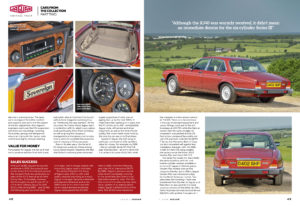
Classic Jaguar – December 2019
Series III Swansong
D402 GHP Pages 48-49
Fortunately for Jaguar, The Series III met with a positive reaction from both press and public alike at the time of its launch, with Autocar magazine summing it up as “Perfecting the near-perfect”. At the very least, the Series III put Jaguar back in contention with its latest luxury saloon rivals (particularly those from Germany) as well as giving the company’s management and engineers some extra time in which to complete the awesome task of creating a fitting successor.
Even in its later years, the Series III XJ range was a popular choice among luxury saloon buyers, helped by the fact that Britain’s motoring press remained largely supportive of what was an ageing line-up by the mid-1980s. It might have been getting on in years, but the XJ continued to offer unmistakable Jaguar style, refinement and driver enjoyment, as well as the kind of build quality that could match most rivals by the time the car was in its final phase.
Typical of Jaguar, the XJ6 range in particular continued to offer excellent value for money. For example, by 1986 -the six-cylinder Series III’s final full year of production – an entry-level XJ6 3.4 carried a list price of £15,595, while the cheapest 4.2 litre version came in at £16,995. Those who fancied more in the way of standard equipment and luxury fittings could opt for the 4.2 Sovereign at £20,795, while the Daimler version with the same straight-six powerplant was pitched at £25,195. Such prices compared favourably not just with premium rivals like the BMW 7-Series and Mercedes-Benz S-Class, but also competed well against less prestigious marques, with the 1986-model 3.4 litre XJ6 being roughly the same price as the Rover 3500 Vanden Plas and Volvo 740 GLE.
SALES SUCCESS
With just 14,861 Jaguars being sold worldwide in 1979, the pressure was on the Series III XJ to help turn around the marque’s fortunes, particularly as sales of the XJ-S were at an all-time low by then. Fortunately, however, the thoroughly revised XJ got off to a fine start, helping Jaguar to shift 15,011 units during 1980 – and 15,562 the following year, by which time John Egan was in charge, tasked with improving Jaguar quality and sales.
The Series III became the focus of Egan’s early efforts, with build quality steadily improving as a result. Jaguar once again became a desirable and inspirational brand, and as the 1980s wore on it came to benefit via increased demand worldwide. Jaguar sales passed the 20,000 mark in 1982, while the following year they hit an impressive 29,175. By 1985, Jaguar’s previous annual sales record was beaten, proving to the world that the Coventry cat had rediscovered its mojo. The fact that much of this sales success came via an update of an ageing saloon makes Jaguar’s achievements of the early ’80s all the more impressive.
The Series III’s model mix was initially the same as before, with six- and twelve-cylinder versions available in a choice of Jaguar or Daimler guises. Vanden Plas models were at first unique to Daimler, but in 1981 a Jaguar Vanden Plas was introduced solely for the North American market. Two years later the Sovereign names was transferred from Daimler to Jaguar, and from then on was used for the most luxurious versions of the latter. By 1987, Series III production had reached almost 168,000. With another five years of the XJ12 eventually taking that figure to a rather impressive 177,244 units.
FINAL EXAMPLE
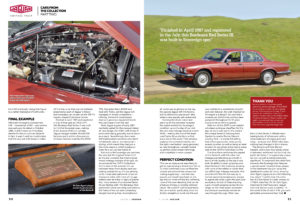
Classic Jaguar – December 2019
Series III Swansong
D402 GHP Pages 50-51
Although the eagerly awaited new XJ6 – codenamed XJ40 – was warmly received upon its debut in October 1986, it didn’t mean an immediate demise for the six-cylinder Series III. In fact, it wasn’t until six months later that the very last XJ6 Series III rolled off the line, a car that was immediately preserved as part of Jaguar’s history and nowadays can be seen at the JDHT’s Gaydon-based Collection Centre.
Finished in April 1987 and registered in July of that year as D402 GHP, this Bordeaux Red Series III was built to 4.2 Sovereign spec, making it the dearest of the six-cylinder Jaguar-badged models. Its £20,795 list price put it within a few pounds of newer German rivals like the BMW 735i, Mercedes-Benz 420SE and Audi 200 Turbo, yet the Jaguar still managed to remain competitive – offering the kind of understated style and generous equipment levels that set it apart from the rest.
Most Jaguar buyers of early 1987 inevitably opted for the marque’s latest all-new design, the XJ40, with the Series III production being gradually wound down as a result. Nevertheless, there were still traditionalists out there who didn’t immediately take to the newcomer’s styling, which meant they had just a few more weeks in which to place an order for a six-cylinder Series III.
Not only is the Sovereign you see here the very last XK-engined Series III of all, it’s also probably the most original lowest-mileage example of its type. As we arrived at the JDHT’s Collection Centre back in the summer, the car had been taken from display and was waiting outside for us, the sun glinting on its immaculate paintwork. It was an impressive sight, with none of the age-related wear and tear or signs of patina that many owners of unrestored Series IIIs are familiar with. The Bordeaux Red paintwork’s shine was deep and lustrous, the flanks of the car were completely straight and ding-free, the brightwork all round was as glorious as the day this special Jaguar left the factory, and its distinctive ‘pepperpot’ alloy wheels were equally well-preserved.
Opening the driver’s door and glancing at the odometer revealed the reason behind the Sovereign’s condition, as on the day of our visit the car’s total mileage stood at a mere 3042 – making this one of the least-used Series IIIs you’re likely to find anywhere in the world. That certainly explains the unmarked leather interior, with the light-hued leather being genuinely as-new throughout, complemented by perfect wood veneer trimmings and completely unworn carpets.
PERFECT CONDITIONS
This was a close as we were likely to get to experiencing a ‘brand new’ Series III, a fact confirmed once we lifted the bonnet and admired the untouched-looking engine bay – one that was exactly as it would have been on the day this car rolled off the line, suffering none of the over-detailing that can be a feature of many a recently restored classic. We couldn’t wait to experience the car in action, particularly once the 4235 cc straight-six burst into life and soon settled to a wonderfully smooth and even tickover. Any well-maintained XK engine is a delight, but one that’s covered just 3000 miles and has been pampered throughout its 32 years is sure to be something special.
With one of the JDHT’s ever-helpful volunteers acting as a chauffeur for the day, we were soon out on the road in this unique Series III, heading from Gaydon to Burton Dassett Country Park – a wonderful setting that offers spectacular views across several counties, as well as being an ideal location for any photo shoot taking place near to the JDHT’s Collection Centre.
The drive there reinforced the appeal of the Series III, with this ultra-low mileage example being as smooth in terms of ride quality as the day it was built. Its ability to soak up bumps and imperfections in the road was uncanny. With none of the rattles or clonks that can afflict high-mileage examples. And once the 4.2-litre XK unit was up to normal operating temperature, we got to appreciate what a gem this particular example is, its lack of miles ensuring super-smooth progress across the rev range, as the three-speed automatic transmission seamlessly worked its was through the cogs. When new, the 4.2 litre Series III offered class-leading levels of refinement, with a remarkable lack of engine and road noise – and just over 3000 miles later, nothing had changed in this instance.
The drive to and from Burton Dassett, with a two-hour photo shoot in between, reinforced the fact that this particular Series III is a genuinely unique survivor, as well as being historically significant. To emphasise the latter fact, however, the Sovereign also features a special wood-mounted brass plaque in the oddments tray just below the dashboard’s centre air vents, showing John Egan’s signature and the following inscription: “I certify that this is the last 4.2-litre Series III made, chassis no. 477824, date May ’87. Sir John Egan, Chairman & Chief Executive, Jaguar Cars Ltd, Browns Lane, Coventry.“ In the world of the Series III XJ6, you can’t get better provenance that that.
Words: Paul Guinness
Photography: Matt Woods